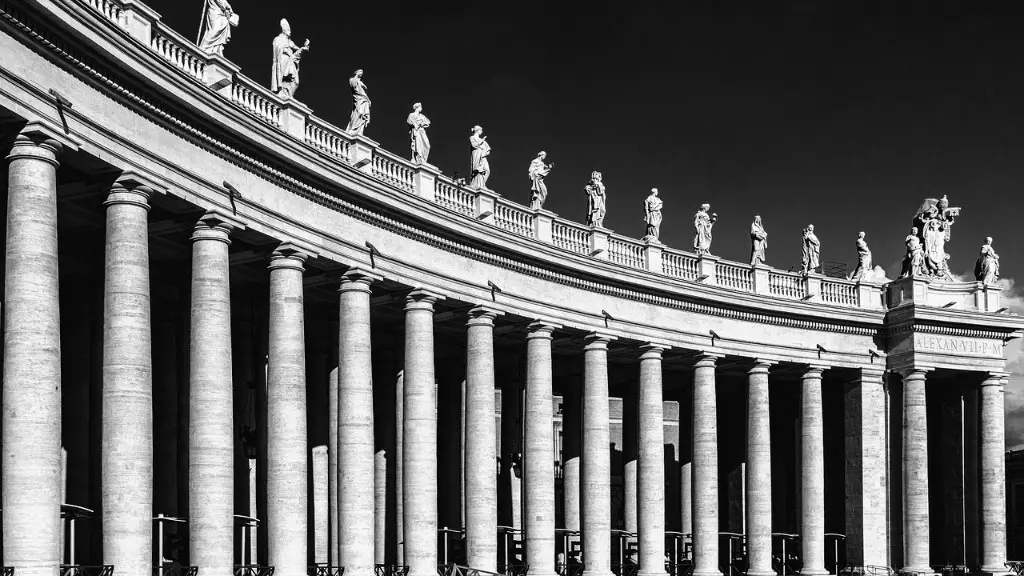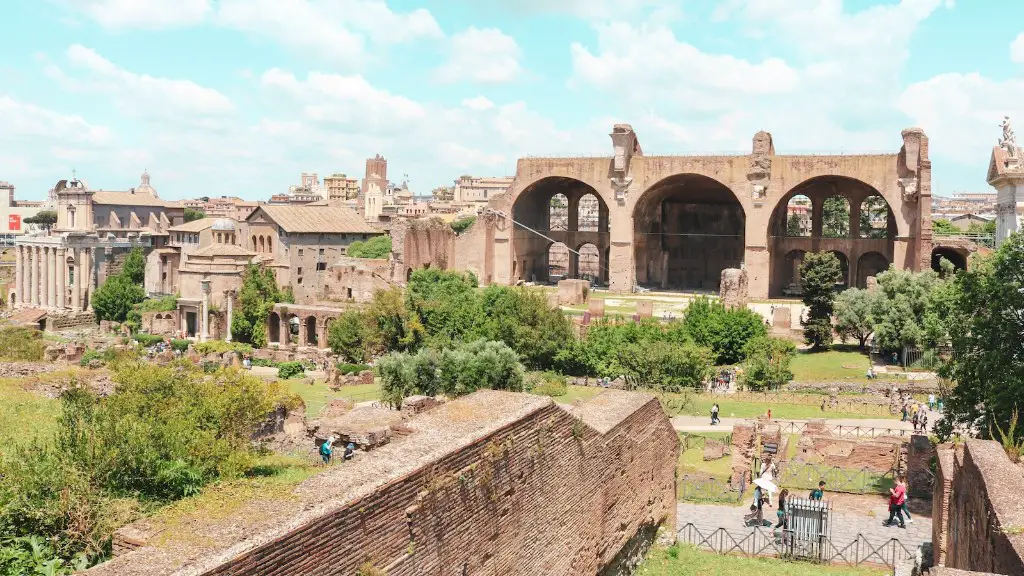Different forms of art were popular in Ancient Rome, including painting, sculpture, architecture, and mosaic. Ancient Roman artists often created art for the purpose of conveying religious or political messages. For instance, many of the statues of Roman emperors were intended to convey a sense of power and strength. Ancient Roman art was also frequently used for decoration, as many homes and public buildings were adorned with elaborate works of art.
Ancient Rome did not have a centralized government like modern nation-states. Instead, its vast territory was governed by a complex system of local rulers and officials. This decentralized system meant that there was no one Roman style of art. Instead, Roman art was a mix of different styles from different parts of the empire.
What did the Romans use for art?
The Roman world was a beautiful place, with many different art forms on display. Seal-cutting, jewellery, glassware, mosaics, pottery, frescoes, statues, and monumental architecture were all used to beautify the Roman world and convey different meanings. Military prowess, fashion, and aesthetics were all conveyed through these different art forms.
Roman art is a very broad and encompassing term. It can refer to anything from painting and sculpture, to mosaics and even silver and bronze work. Roman art is characterized by its realism and its use of perspective. Roman artists were also very skilled at using light and shadow to create a sense of depth and realism in their work.
How were Roman paintings made
The Romans used wall paintings as a way to open up and lighten their space. More specifically, they used frescoes. A fresco is made by first preparing the wall with 1-3 coats of mortar (a lime and sand mix), then covering that with 1-3 coats of lime mixed with finely powdered marble.
Although ancient literary references inform us of Roman paintings on wood, ivory, and other materials, works that have survived are in the durable medium of fresco that was used to adorn the interiors of private homes in Roman cities and in the countryside. Fresco painting was a popular form of art in ancient Rome due to its ability to brighten up homes and its long-lasting nature. Frescoes would often depict scenes from Roman mythology or everyday life, and were a way for people to add a personal touch to their homes.
What made Roman art unique?
Roman public art was heavily focused on commemorating important individuals, often using portrait style artwork. This later Republic period saw a rise in portrait style art of leading Romans, which was likely influenced by both native portraiture traditions and Hellenistic interest in physiognomy.
The civilization of Ancient Rome was one of the most powerful empires in Europe for over 1000 years. The arts flourished during this time and were often used by the wealthy and powerful to memorialize their deeds and heritage. Rome was a major center of culture and art, and many of the most famous works of art from this period come from Rome.
What techniques did Romans use for painting?
There is now general acceptance among specialists that fresco was the most common painting technique in Roman murals during recent decades. As a result, it is now common practice in museums to state that fresco was the technique used in Roman murals within their collections.
Roman portraits are known for their realism, and some scholars believe that this is because they evolved from wax death masks. Death masks were made from the actual faces of the deceased and were kept in a home altar. In addition to wax, masks could also be made from bronze, marble, or terracotta.
What did Roman art mostly focus on
Roman art is characterized by its realism, as well as the skillful use of color and light to create a sense of depth. Roman artists often used perspective to create the illusion of three-dimensional space on a two-dimensional surface. They also used a variety of different media, including painting, sculpture, and mosaics.
Art is a timeless expression of human creativity and ingenuity. The Roman Empire was one of the great cultural centers of its time, and its art reflected the grandeur and power of the empire. Many of the art forms practised by the Romans – such as sculpture, painting, and decorative art – were already well-established by the time of the Roman Empire. The Roman artists took these existing art forms and added their own unique flair, creating art that was both beautiful and reflective of the times.
What is important about Roman art?
Roman art is significant because it offers a glimpse into the culture and values of Rome. The art reflects the pride and power of the Roman empire. It also depicts the various aspects of Roman life, such as religion and architecture.
The major periods in Imperial Roman art are named after individual rulers or major dynasties, they are: Augustan (27 BCE-14 CE) Julio-Claudian (14-68 CE) Flavian (69-98 CE. The Julio-Claudian dynasty is the first imperial dynasty of Rome, which lasted from the death of Caesar Augustus in 14 CE to the death of Nero in 68 CE. The Flavian dynasty was founded by the general and politician Vespasian, who became Emperor in 68 CE, and ended with the death of Domitian in 96 CE.
What are 3 facts about Roman art
Roman art is characterized by its realism and the skillful use of perspective for dramatic effect. Roman artists often used perspective to create the illusion of depth and distance in their paintings, Mosaics were a popular form of Roman art, and many beautiful examples can still be seen today. The Roman love of sculpture is also evident in the many surviving statues and busts from the period. Rich Romans often had their coffins decorated with elaborate carvings and art, and many fine examples of Roman funerary art can be seen in museums today.
The term “classical art” refers to the art of the ancient Greeks and Romans. This name is used also to describe later periods in which artists looked for their inspiration to this ancient style. Classical art is characterized by a strong sense of order and symmetry, and a focus on realism and idealism.
Was Roman art realistic?
It seems that Roman portraits were more realistic in their depiction of physical features and psychological states when compared to earlier Greek images. This could be due to a number of factors, including the increasing popularity of realism in the art world during this time period. It could also be a reflection of the growing importance of the individual in Roman society. Whatever the reason, it is clear that Roman artists were interested in creating more lifelike images of the people they were representing.
The Romans disliked wrinkles, freckles, sunspots, skin flakes and blemishes. To soften wrinkles, they used swans’ fat, asses’ milk, gum Arabic and bean-meal. Sores and freckles were treated with the ashes of snails.
What materials did Roman sculpture use
Roman sculpture is characterized by its realism and the skillful use of perspective for dramatic effect. As with Greek sculpture, the Romans worked stone, precious metals, glass and terracotta but favoured bronze and marble above all else for their finest work. However, as metal has always been in high demand for re-use, most of the surviving examples of Roman sculpture are in marble.
Roman sculptors were especially adept at creating lifelike portraits and statues of gods and heroes. One of the best-known examples is the statue of Augustus Caesar, which was erected in Rome in the early first century AD. Augustus is shown in a realistic and lifelike manner, and the statue conveys a sense of his power and authority.
While Roman sculpture often borrowed heavily from Greek sculpture, it also developed its own distinctive style. For instance, Roman sculptures often featured more emotional expressions than their Greek counterparts. Additionally, Roman sculptors often used perspective for dramatic effect, as in the famous statue of Constantine the Great, which shows the emperor in a dramatic standing pose.
Roman artists used a variety of materials to create their sculptures, including marble, stone, clay, and concrete. The invention of concrete was a major breakthrough for Roman sculptors, as it allowed them to create large and complex structures that would have otherwise been impossible. The popularity of sculptures of people led to the creation of many copies of each sculpture, similar to what we would today think of as a production line.
Final Words
Ancient Rome made art by using a variety of materials, including stone, clay, and metal. They also used a variety of techniques, including carving, painting, and mosaic-making.
The ancient Romans were quite skilled in the art of sculpture and painting. Their artwork was often very realistic and often featured themes from mythology or everyday life. The ancient Romans also enjoyed creating mosaics, which were pictures made out of small pieces of stone or glass.





